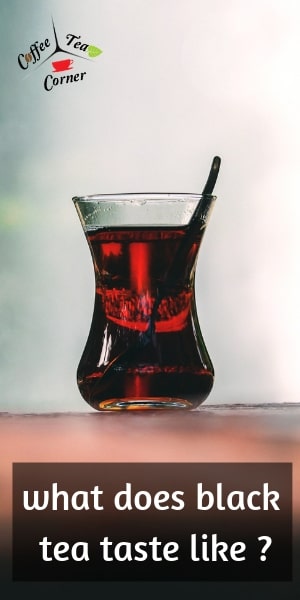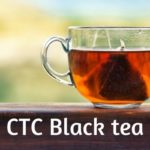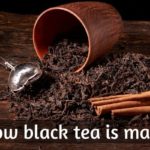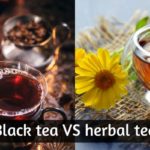 Trying to figure out what black tea would taste like before you have a cup ? I know black tea can be intimidating, especially if you're used to sweeter, fruitier teas.
Trying to figure out what black tea would taste like before you have a cup ? I know black tea can be intimidating, especially if you're used to sweeter, fruitier teas.
But if you're very much into coffee, then black tea might not be that far off for you. Let me explain.
Table of Contents
So what does black tea taste like ?
Black tea has a distinctly dark and malty flavor, a bit like a very light beer without the alcohol or acidity. It's a very oxidized tea, so it will produce a dark red/orange looking brew.
Unlike green tea it does not taste grassy or fresh, but rather has a deep aroma, a bit nutty and definitely bold.
Poorly made black teas can taste papery and too vegetal, like flower vase water. But a good black tea will have a strong aroma, less bitter than a green tea, and will welcome sugar and cream very well.
In some cases black teas can develop a fruity tone, or a very spicy one, and at times even floral. This is something I'll get into when we get into the the different black tea types.
But first, let's see what black tea is, and how it's made so we can understand why and how black tea gets its flavor.
What is black tea, and how it's made (short version)
Black tea is tea made from the leaves of the Camellia sinensis plant, much like green tea and white tea. But where green and white tea are very lightly oxidized and produce a lighter tea (both in color and taste), black tea is a very oxidized one.
As such this tea is always going to have a different, bolder flavor compared to green or white tea.
This bold, caffeinated drink is what the English brought into India to start cultivating tea and break the Chinese monopoly.
It's long been used as a drink in the morning, even afternoons, as a little pick me up for very long days. This is how the English breakfast came to be, since coffee wasn't a very common thing to drink in the morning when black tea came around.
Funnily enough this black tea in the West is what the East calls red tea rooibos. Not to be confused with the West's red tea, which is Rooibos from the South African provinces.
Regarding how it's made, black tea is made from the same tea leaves as the green tea, only they are oxidized for longer. After the leaves are picked, they are either torn to smaller pieces and then left to dry, or left whole to dry.
After drying the leaves are then oxidized so that they can be used for a longer time. As in, green tea loses its flavor after about a year, but black tea retains it for several years.
This has largely to do with the different process the leaves go through. This is the only way to make black tea, since oxidizing them less would result in an Oolong or green tea.
Another thing to note is that not all black teas are made of Camellia sinensis plant. Some are made from the Assam tea plant, which is a variation on the Camellia plant.
Often you will find black teas which are actually blends of several types of leaves, for example an Assam (region in India) blended with a Ceylon (Sri Lanka) and a Darjeling (also India) are not uncommon.
But let's talk about these different black tea types, and how they differ from one another. This is something that you will need to know what you buy your tea, much like you need to know what kind of coffee beans you're buying.
(If you like this article so far, you can pin it to your Pinterest board by clicking the image below. The article continues after the image.)
Different black tea types bring different flavors and notes
There are quite a few black teas in the world, most of them being consumed in the West. Unless you're from a part of the world where black tea is very common (like India, Sri Lanka, the UK, etc) you might not know that there's more than one black tea.
I didn't know, and I only grew up with one lousy box of black tea, which we rarely ever used. It was a terrible, poor quality tea and to this day I'm not sure exactly what type it was meant to be.
But it came in a large black box with a tiger on it, and it was 100 teabags. They tasted like wet paper and that was my first foray into black tea.
I've since noticed there are quite a few black tea versions out there, and I'm going to help you out with the most common ones you will find on the market.
Assam black tea
This is the tea made from the leaves of the Assam tea plant. It grown in Assam, India and it has a very strong, malty flavor. It's what is most commonly used in black teas across the world.
An Assam is what you probably have in your breakfast tea, or at least part of it will be Assam unless specified. Since it's such a strong and bold tea, it goes great with a drop of milk.
Darjeeling black tea
Darjeeling black tea is a special one, since it comes in two varieties - first flush and second flush. Both varieties come with a bit of a musky, spicy aroma to them.
The Darjeeling first flush is made of the leaves of the tea plant when it first 'flushes', or produces its first leaves of the year. This is often a flowery, lighter kind of black tea.
The second flush is made of the leaves that grow a couple of months later in the season after the first flush. This tea is a darker one, with a fruitier aroma compared to the first flush.
Any subsequent flushes after the second will produce a lower quality black tea, and are rarely sold outside of India.
Ceylon black tea
This black tea is made and grown in Sri Lanka, where it grown upon 3 districts. The Upcountry, Mid country and Low country districts produce different tea grades, since altitude and climate influences the final taste.
Ceylon tea grown in the Upcountry is a lighter black tea, and even its brew has a lighter hue, more like honey rather than the dark red.
The Mid country provides a strong and rich aroma, and the tea is a full bodied one.
The Low country black teas are stronger, but their quality is lower than the Mid country ones.
Overall Ceylon tea is considered to be a high quality tea due to how well the country of Sri Lanka is positioned and its great climate when it comes to tea farming. High elevation, slopes to grow the Camellia sinensis on, warm days and plenty of rainfall, with shade and sunshine to spare.
Breakfast black tea
Breakfast teas aren't a type of tea per se, but they're a common enough black tea blend that you'll need to know about them as well. Most breakfast teas are Assam teas, since they have a stronger, bolder flavor and take milk very well.
Most of the time though you'll find breakfast teas as a blend between the 3 main black tea types I described before (Assam, Ceylon, and Darjeeling).
For named breakfast teas like English breakfast or Irish breakfast the composition is not a specific one, but rather a marketing move.
Lapsang Souchong black tea
This particular black tea is a very dark and smoky tea. This is due to how the tea leaves are dried over an open fire made of pine wood, in the Fujian province of China.. This gives the tea a wonderful smoky flavor, and in most cases it's not recommended to drink with milk.
However this tea is almost never bitter, but instead nutty and smoky, and it produces a dark amber color in its brew.
Yunnan black tea (Dianhong)
Another Chinese black tea, the Yunnan is on the higher end of the black teas. It's one of the most red black teas out there, and its aroma is generally a spicy and floral one.
You might find it in several tea blends, depending on the tea house. If it's a high quality tea it will be a delicate, sweet aroma and almost no astringency at all, with a dark red-orange brew. If it's a lower end one then it might just be a very bitter tasting tea, and will look dark brown.
Blended black teas
These are the most common teas on the market for Westerners. When you walk into the supermarket you will see more often a black tea with lemon or Earl Grey (or Lady Grey) than a simple Assam or Ceylon.
Often times even the teas that look fruity when you first look at them, you will notice they have a smaller print saying it's a black tea with fruit flavor. Nothing wrong with that, just a reminder to read everything on a box of tea before you bring it home.
For me personally blended black teas (and teas in general, I might say) are the best option. I'm more of a flavor person, and as such I prefer a nice Earl Grey over a simple breakfast tea.
Of course there are so many options of blended black teas out there the possibilities are pretty much endless. Recently I've bought a Bourbon vanilla black tea, and it goes very well with milk. Before that I had a caramel black tea. Also went well with milk.
And before that I had a spiced black tea (cinnamon, cardamom, chili, nutmeg, and so on) and it was pretty much the perfect winter tea. Not very great with milk though.
If you've never had black tea before, I strongly suggest you start with a blended black tea at first, and then gradually move into a simple black tea so you can taste the different nuances in your teas.
Black tea goes very well with sugar and cream, sometimes lemon
When it comes to what additional flavors black tea takes, I think it's the best tea to have with milk and sugar, right after a cup of Rooibos. I only say this because I like how the naturally sweet aroma of a Rooibos blends with milk.
If you like a sharper tea to cut through your milk or cream, then you'll like black tea better. It goes very well with pretty much anything you set your mind to add to it.
Breakfast teas are almost always served with milk and sugar, much like coffee. Of course this works better with a stronger black tea rather than with a lighter one, like an Assam would go better with milk than a delicate Darjeeling first flush.
Brown sugar is something I would recommend you try in your black tea, since it gives the sweetness a depth that regular white sugar simply doesn't have. It works with coffee, but it works just the same with black tea.
As for lemon or other fruits, black tea is again a champion. It will take the zest of a lemon or orange very well, and even just a drop of essential lemon oil is going to lift the entire brew.
Seeing as it's a black tea, it wont have that overly citrusy feeling, but instead be a grounded flavor. It's something I love to brew in the summer, and serve it hot (yes, you read right) with a slice of lemon or grapefruit in the cup.
Another thing to try is a stick of cinnamon in your black tea. This works especially well if you're making a big pot of tea for several people and can leave a whole stick in there to infuse the tea.
For just one cup of tea a whole stick is too much, and powdered cinnamon doesn't dissolve in water. But put it in a whole pot of tea and you'll get a beautiful brew.
An example of black teas you might like
Simple, pure black tea
This black tea is an Assam breakfast tea. This is pretty much the strongest and most common kind of black tea you will find on the market.
It comes in 50 unbleached tea bags, so it's good for 50 cups of tea. You can try reusing the tea bag if you want, these teas are meant to be of a higher quality.
Seeing as Assam is a full bodied black tea, it will take well any sugar or milk to add to it (if you want).
You can check the listing on Amazon here, and read the reviews as well.
Blended black tea
This little guy is a mango and black tea blend. A Ceylon black tea, no less.
Fruity black teas are a wonderful thing to have around the house, since they will go well both hot and cold. You can make your own iced tea with this one, or serve it hot if you want to.
It's the kind of tea I would routinely reach for, at any time of the day. Do remember though that this is black tea and does have some caffeine in it. So if you know you're very sensitive to caffeine don't have more than a cup in the evening.
Seeing as this is a loose leaf tea the container will empty according to how much tea you use for each cup. As also because this is a loose leaf tea, you will be able to get a second cup of tea from the same leaves easier.
You can check the listing on Amazon here, and read the reviews as well.
The way you brew your black tea affects the taste
Alright, now let's see how you should brew your beautiful black tea. As with all teas, the leaves are sensitive and should not be scalded. That being said, this kind of tea is the most processed one and can handle a higher temperature.
This means that you water should be at 90 C/194 F and you will need to steep you tea for about 3-5 minutes. You'll notice the color coming out of the leaves immediately, and the aroma of dark, strong tea wafting from your cup.
Now some teas might not produce a very dark color. That's alright, not all black teas will give you a dark red tea. Some are only amber or orange in their brew, but this is how they're meant to be.
If you use water that's too hot, or leave the tea steeping for too long you risk making yourself a very bitter tea. Now it won't be as harsh as a bitter green tea, but it will still be noticeable.
So please remember to not oversteep your black tea. You can always reuse the leaves, but remember to use a slightly higher temperature and a longer steeping time. Even then, the resulting infusion will be a weaker one so don't expect it to be as strong as your first cup.
Final thoughts
When looking to try a black tea, you should take into account that it's a lot like with coffee. The initial taste might be odd, and there are people out there who take their black tea as-is. Some might not like it without milk or sugar, and you won't know which one you like until you try them.
So if you've never had black tea before, remember that it's not going to be like any other tea you've had before. Still, it's the one tea that takes well to tweaking with milk or sugar so you can adjust it to your liking.
If you want to know more about coffee or tea, feel free to check the related articles below. Who knows what else you might find ?







